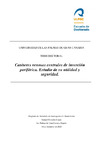Please use this identifier to cite or link to this item:
https://accedacris.ulpgc.es/jspui/handle/10553/105775
| Title: | Catéteres venosos centrales de inserción periférica. Estudio de su seguridad y utilidad | Authors: | González López, Samuel | Director: | Ruiz Santana, Sergio Hernández Socorro, Carmen Rosa |
UNESCO Clasification: | 32 Ciencias médicas 3201 Ciencias clínicas |
Keywords: | Catéter central de inserción periférica Bacteriemia asociada a catéter vascular Bacteriemia relacionada con catéter vascula Bacteriemia primaria Trombosis venosa profunda |
Issue Date: | 2021 | Abstract: | Objetivo: evaluar la seguridad y utilidad de los catéteres PICC implantados mediante la cuantificación de las complicaciones durante la inserción y el uso del catéter, así como la cumplimentación del tratamiento. Métodos: estudio de cohorte prospectiva de 5 años realizado en un hospital universitario de tercer nivel, en pacientes adultos sometidos a inserción de PICC. Se registraron las complicaciones en la implantación y durante el uso de los catéteres PICC, fundamentalmente bacteriemias asociadas al catéter vascular (BACV), incluidas las bacteriemias relacionadas con el catéter (BRCV) y bacteriemias primarias (BP), así como las trombosis venosas profundas (TVP). Los predictores independientes de complicaciones se evaluaron mediante análisis multivariante. Resultados: se insertaron un total de 1.142 PICC, con 153.191 días de catéter (mediana 79 días). No se identificó ninguna complicación mayor durante la inserción del catéter. Las complicaciones durante el uso del catéter incluyeron 66 casos de BACV (5,78%, 0,43 ‰ días de catéter), 38 de BRCV (3,33%, 0,25 ‰ días de catéter), 28 BP (2,45%, 0,18 ‰ días de catéter) y 23 TVP (2,01%, 0,15 ‰ días de catéter). La nutrición parenteral (OR 3,40, IC 95% 1,77-6,52) y el ingreso en el Servicio de Hematología (OR 4,90, IC 95% 2,25-10,71) se asociaron de forma independiente con BRCV y BP, respectivamente. El ingreso a cargo de Hematología (OR 12,46; IC del 95%: 2,49-62,50) u Oncología (OR 7,89; IC del 95%: 1,77-5,16) se asoció de forma independiente con TVP. El 81,3% de los PICC se retiró sin fallo del catéter, fundamentalmente por finalización del tratamiento. Solo dos pacientes murieron por complicaciones relacionadas por el catéter. Conclusiones: los PICC son dispositivos seguros ya que muestran una baja tasa de complicaciones trombóticas e infecciosas. Además, la ausenciade complicaciones mayores durante la inserción supone una importante ventaja con respecto a otros catéteres centrales. Han resultado también útiles para la cumplimentación del tratamiento del paciente. Objective: To assess safety and usefulness of implanted PICC catheters by quantifying complications during insertion and use, as well as compliance with treatment. Methods: 5-year prospective cohort study at tertiary care teaching hospital. Catheter-associated bloodstream infection (CABSI) includingcatheter-related bloodstream infection (CRBSI) and primary bacteremia (PB), and upper extremity deep vein thrombosis (UEDVT) were recorded. Independent predictors of complications were assessed by multivariate analysis. Results: A total of 1,142 PICCs were inserted, with 153,191 catheter days (median 79 days). No complicationswere identifiedduring insertion procedure. Complications during use included 66 cases of CABSI (5.78%, 0.43‰ catheter days), 38 of CRBSI (3.33%, 0.25‰ catheter days), 28 PB (2.45%, 0.18‰ catheter days), and 23 UEDVT (2.01%, 0.15‰ catheter days). The median time to infection was 24, 41 and 60 days for CRBSI, PB and UEDVT, respectively. Parenteral nutrition (OR 3.40, 95% CI 1.77-6.52) and admission to the hematology ward (OR 4.90, 95% CI 2.25-10.71) were independently associated with CRBSI and PB, respectively. Admission to the hematology (OR 12.46, 95% CI 2.49-62.50) or to the oncology (OR 7.89, 95% CI 1.77-35.16) wards was independently associated with UEDVT. 81.3% of PICCs were removed without catheter failure, mainly due to the end of treatment. Only two patients died of complications. Conclusions: PICCs are safe devices as they show a low rate of thrombotic and infectious complications. Furthermore,the absence of major complications during insertion is an important advantage over other central catheters. They have also been useful for the compliance of the patient's treatment. |
Description: | Programa de Doctorado en Investigación en Biomedicina por la Universidad de Las Palmas de Gran Canaria | Department: | Departamento de Ciencias Médicas y Quirúrgicas | Faculty: | Facultad de Ciencias de La Salud | URI: | https://accedacris.ulpgc.es/handle/10553/105775 |
| Appears in Collections: | Tesis doctoral |
Page view(s)
1,279
checked on Nov 1, 2024
Download(s)
7,249
checked on Nov 1, 2024
Google ScholarTM
Check
Share
Export metadata
Items in accedaCRIS are protected by copyright, with all rights reserved, unless otherwise indicated.
